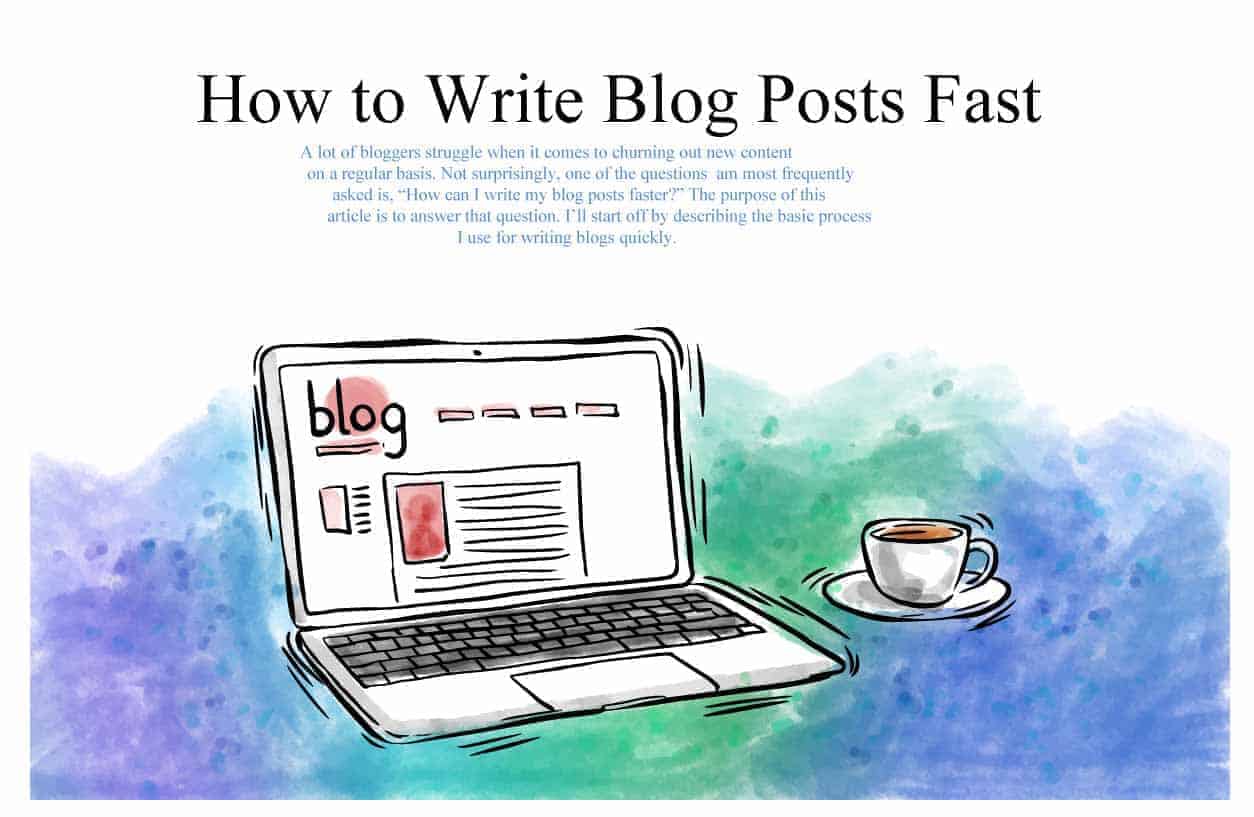A lot of bloggers struggle when it comes to churning out new content on a regular basis. Not surprisingly, one of the questions I am most frequently asked is, “How to write blog fast?” The purpose of this article is to answer that question. I’ll start off by describing the basic process I use for writing blogs quickly. Next, I’ll provide some specific guidelines for each of the main types of posts, and then slip in a few more general tips. So, let’s get started!
The Basic Process for Writing a Blog Post
Following is the primary process for churning out posts quickly. Following these steps, in order, will help you stay focused, avoid getting stuck, and finish your posts faster.
1. Select a topic and narrow it down.
 For example, let’s say you want to write about essential oils. That topic is obviously too broad to cover in a blog post. You could try narrowing it down to “Tea Tree Oil,” which helps, but it’s still too broad. Keep narrowing until you have something you can cover in 1000-1500 words. I was in that exact position a few months ago. The appropriately-narrowed topic I settled on was “Home Remedies Using Tea Tree Oil.” This process is known as “sharpening the pencil” and doing it first saves you a ton of time later.
For example, let’s say you want to write about essential oils. That topic is obviously too broad to cover in a blog post. You could try narrowing it down to “Tea Tree Oil,” which helps, but it’s still too broad. Keep narrowing until you have something you can cover in 1000-1500 words. I was in that exact position a few months ago. The appropriately-narrowed topic I settled on was “Home Remedies Using Tea Tree Oil.” This process is known as “sharpening the pencil” and doing it first saves you a ton of time later.
2. Create an outline.
Always, always write an outline. An outline keeps you organized, focused, and as a result, you will write faster. There is plenty more to say about this step depending on the type of post you are writing, all of which we’ll discuss in the next section.
3. Write the body one part at a time.
If your outline is sound, the writing process is just filling in the holes. Don’t necessarily try to start at the beginning and write through to the end. It is too easy to get stuck that way. Write one chunk at a time and if you get stuck on one, move to another and then come back to it.
4. Write the intro and conclusion.
Yes, this happens AFTER you write the body. It is easy to get bogged down here and start spinning your wheels and going nowhere. For this reason, I suggest waiting until you are done with the body before you write the introduction and conclusion.
5. Edit.
Writing and editing are two separate activities. Proofread, wordsmith and fine-tune your post after it is written, not while you are writing it. Nothing will slow you down more than dithering with words and fonts before you complete the first draft. Save these activities for the editing phase.
6. Publish.
Simple as that.
Refining Your Basic Outline Based on Post Type
Alrighty then! Now that we have talked about the primary process let’s look at improving your outline based on the type of post you are writing. There are four main types of post. They are:
- Posts that explain how to do something
- Posts that are intended to convince the reader to do something
- Posts that describe or explain something
- Posts that express an opinion
1. Posts that explain how to do something
 This type of post is frequently referred to as a “How-To” article. It provides step-by-step instructions and usually has the words “How to” in the title. This article falls into the How-To category.
This type of post is frequently referred to as a “How-To” article. It provides step-by-step instructions and usually has the words “How to” in the title. This article falls into the How-To category.
The body of the outline (everything between the Introduction and the Conclusion) will state and describe each step, in the order, they are performed. For example, go back and take another look at the Basic Process section.
Here is a typical How-To outline:
- Introduction
- Step 1.
- Step 2.
- Step 3…
- Conclusion
2. Posts to convince someone to do something
This type of post is intended to persuade someone to do something. It usually contains the word “Why” in the title; e.g., “Why You Should Avoid Processed Sugar.”
The introduction of this type of post usually states what you want the reader to do. The body then states and describes each reason, in order.
This is a typical persuasion outline:
- Intro
- Reason 1
- Reason 2
- Reason 3…
- Conclusion with Call to Action
3. Posts that describe or explain something
This type of post is about presenting information that is useful to your audience. The title is usually the thing being described or illustrated, and often contains words such as “What is,” “Explained,” “101”, “The Basics,” “What you need to know about,” or “For Dummies.” Product descriptions fall into this category, as do any other articles that present information on a particular subject. Here are some examples of posts I have written recently:
- The Latest FDA Product Label Guidelines
- Mindfulness Diet: The Basics
- Paleo Diet Explained
- What Everyone Needs to Know About Saturated and Trans Fats
Usually, the introduction of this type of post provides background. (Why does this thing need to be explained? Is it new, misunderstood, or has it changed?) The body then includes a high-level description of what is being illustrated or described, its purpose, and then its specific characteristics or features.
Here is a sample informational outline:
- Intro
- High-level description
- Purpose
- Characteristic 1
- Characteristic 2
- Characteristic 3…
- Conclusion
4. Posts that express a point of view
These types of posts are generally intended to express an opinion and/or provoke a discussion. The title almost always includes a brief statement of the advice and may also add the word “Why.” Examples:
- Why Trump is Unqualified to be President
- This is Why I’m Not Voting This Year
- The American Economy is Rigged
- The NRA is Endangering America
The intro of this type of post is usually a brief statement of the point of view. The body often contains a description of the issue, why it is essential, and then a list of reasons to support your opinion.
- Intro
- Description of the issue
- Why the issue is important
- Reason 1
- Reason 2
- Reason 3…..
- Conclusion
Final Tips and Guidelines
Following are some general tips and guidelines that apply to all posts. Following them should help keep you on track no matter what type of post you are writing.
The introduction. Don’t spin your wheels here. Focus on two things: a) Give the reader some idea of what the post is about, and b) make them want to read more. The same goes for Titles.
The conclusion. A conclusion should provide closure. Remember, you’ve already said what you had to say. Wrap it up in a sentence or two and be done with it.
Tone. Blog posts are expected to be conversational, not a dissertation. This means to write in your own voice. If you find yourself struggling for the “right” words, just ask yourself how would you say it if you were talking to a friend and then write that down.
In Conclusion…
These tips have helped me write faster and hopefully, they will do the same for you. As always, happy blogging!


 Protected by Patchstack
Protected by Patchstack